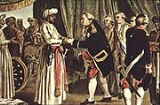
Franco-Indian alliances
Encyclopedia
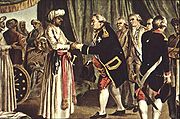
Joseph François Dupleix
Joseph-François, Marquis Dupleix was governor general of the French establishment in India, and the rival of Robert Clive.-Biography:Dupleix was born in Landrecies, France...
, a formal alliance was formed between by Louis XVI's France during the late 18th century in an attempt to oust Great Britain
Great Britain
Great Britain or Britain is an island situated to the northwest of Continental Europe. It is the ninth largest island in the world, and the largest European island, as well as the largest of the British Isles...
from the Indian subcontinent
Indian subcontinent
The Indian subcontinent, also Indian Subcontinent, Indo-Pak Subcontinent or South Asian Subcontinent is a region of the Asian continent on the Indian tectonic plate from the Hindu Kush or Hindu Koh, Himalayas and including the Kuen Lun and Karakoram ranges, forming a land mass which extends...
. Later, numerous proposals of alliance were made by the Indian Sultan Tippu Sahib, leading to the dispatch of a French fleet of volunteers to help him, and even motivating an effort by Napoleon to make a junction with India, through the 1798 Campaign of Egypt, and later diplomatic efforts at obtaining the support of the Ottoman Empire
Ottoman Empire
The Ottoman EmpireIt was usually referred to as the "Ottoman Empire", the "Turkish Empire", the "Ottoman Caliphate" or more commonly "Turkey" by its contemporaries...
and Persia for an onland offensive towards India.
Early French involvement
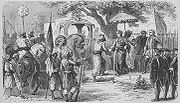
François Bernier
François Bernier was a French physician and traveller. He was born at Joué-Etiau in Anjou. He was the personal physician of the Mughal emperor Aurangzeb for around 12 years during his stay in India....
(1625–1688), a French
French people
The French are a nation that share a common French culture and speak the French language as a mother tongue. Historically, the French population are descended from peoples of Celtic, Latin and Germanic origin, and are today a mixture of several ethnic groups...
physician
Physician
A physician is a health care provider who practices the profession of medicine, which is concerned with promoting, maintaining or restoring human health through the study, diagnosis, and treatment of disease, injury and other physical and mental impairments...
and traveler, became for 12 years the personal physician of the Mughal
Mughal Empire
The Mughal Empire , or Mogul Empire in traditional English usage, was an imperial power from the Indian Subcontinent. The Mughal emperors were descendants of the Timurids...
emperor Aurangzeb
Aurangzeb
Abul Muzaffar Muhy-ud-Din Muhammad Aurangzeb Alamgir , more commonly known as Aurangzeb or by his chosen imperial title Alamgir , was the sixth Mughal Emperor of India, whose reign lasted from 1658 until his death in 1707.Badshah Aurangzeb, having ruled most of the Indian subcontinent for nearly...
.
In the early 18th century, France was actively involved in the powerplay in India
India
India , officially the Republic of India , is a country in South Asia. It is the seventh-largest country by geographical area, the second-most populous country with over 1.2 billion people, and the most populous democracy in the world...
. The French General Dupleix
Joseph François Dupleix
Joseph-François, Marquis Dupleix was governor general of the French establishment in India, and the rival of Robert Clive.-Biography:Dupleix was born in Landrecies, France...
was allied to Murzapha Jung in the Deccan, and Chanda Sahib
Chanda Sahib
Chanda Sahib was the Nawab of the Carnatic between 1749 and 1752. His birth name is Husayn Dost Khan. He was the son-in-law of the Nawab of Carnatic Dost Ali Khan, under whom he worked as a Dewan. He belonged the Muslim Nait community which had ruled the Carnatic under the Nawab Zulfiqar Ali Khan...
in the Carnatic Wars
Carnatic Wars
The Carnatic Wars were a series of military conflicts in the middle of the 18th century on the Indian subcontinent...
, in the conflict against Robert Clive. These relationships were beneficial to the French, and Frnech allies gifted areas such as the Alamparai Fort
Alamparai Fort
Location : 12.2659224N 80.0100804EThe ruins of Alamparai Fort lie near Kadapakkam, a village 50 km from Mamallapuram on the land overlooking the sea. Constructed in the late 17th century during the Mughal era, the Alamparai Fort once had a 100-metre long dockyard stretching into the sea, from...
in return for the services provided by the French against the British.
The French succeeded in the 1746 Battle of Madras
Battle of Madras
The Battle of Madras or Fall of Madras or Battle of Adyar took place in September 1746 during the War of the Austrian Succession when a French force attacked and captured the city of Madras from its British garrison....
, and the French and Indians fought together and vanquished Anwaruddin
Anwaruddin Muhammed Khan
Muhammad Anwaruddin was the 1st Nawab of Arcot of the second Dynasty. He was a major figure during the Second Carnatic War.He was a direct descendant of Hazarath Omar, the Second Caliph of Islam . Nawab Anwaruddin Khan was born at Gopamau, a place in Hardoi District, United Provinces, India in...
in 1749, but failed in the Battle of Arcot
Battle of Arcot
The Battle of Arcot took place on 14 November 1751 in Arcot, India between forces of the English East India Company led by Robert Clive and forces of the French East India Company under Joseph François Dupleix...
in 1751 and finally surrendered in 1752. The French again had a success at the capture of Fort St. David in 1758 under Lally
Thomas Arthur, comte de Lally
Thomas Arthur, comte de Lally, baron de Tollendal was a French General of Irish Jacobite ancestry. He commanded French forces in India during the Seven Years War. After a failed attempt to capture Madras he lost the Battle of Wandiwash to British forces under Eyre Coote and then was forced to...
, but were finally defeated at Masulipatam (1759) and Wandewash (1760).
Alliance of Louis XVI
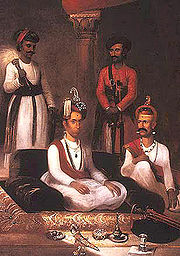
Treaty of Paris (1763)
The Treaty of Paris, often called the Peace of Paris, or the Treaty of 1763, was signed on 10 February 1763, by the kingdoms of Great Britain, France and Spain, with Portugal in agreement. It ended the French and Indian War/Seven Years' War...
, although five trading posts were being maintained there, leaving opportunities for disputes and power-play with Great Britain
Great Britain
Great Britain or Britain is an island situated to the northwest of Continental Europe. It is the ninth largest island in the world, and the largest European island, as well as the largest of the British Isles...
. France was successful in supporting the American War of Independence in 1776, and wished to expel the British from India as well.
In 1782, Louis XVI sealed an alliance with the Peshwa
Peshwa
A Peshwa is the titular equivalent of a modern Prime Minister. Emporer Shivaji created the Peshwa designation in order to more effectively delegate administrative duties during the growth of the Maratha Empire. Prior to 1749, Peshwas held office for 8-9 years and controlled the Maratha army...
Madhu Rao Narayan
Madhavrao II
Madhavrao II , also Madhu Rao Narayan, was Peshwa of the Maratha Empire in India, from a young age. He was known as Sawai Madhavrao...
. As a consequence Bussy
Marquis de Bussy-Castelnau
Charles Joseph Patissier, Marquis de Bussy-Castelnau was the Governor General of the French colony of Pondicherry from 1783 to 1785. He servied with distinction under Joseph François Dupleix in the East Indies, receiving the Order of Saint Louis...
moved his troops to Ile de France (Mauritius
Mauritius
Mauritius , officially the Republic of Mauritius is an island nation off the southeast coast of the African continent in the southwest Indian Ocean, about east of Madagascar...
) and later contributed to the French effort in India in 1783. Suffren
Pierre André de Suffren de Saint Tropez
Admiral comte Pierre André de Suffren de Saint Tropez, bailli de Suffren , French admiral, was the third son of the marquis de Saint Tropez, head of a family of nobles of Provence which claimed to have emigrated from Lucca in the 14th century...
became the ally of Hyder Ali
Hyder Ali
Hyder Ali was the de facto ruler of the Kingdom of Mysore in southern India. Born Hyder Naik, he distinguished himself militarily, eventually drawing the attention of Mysore's rulers...
in the Second Anglo-Mysore War
Second Anglo-Mysore War
The Second Anglo-Mysore War was a conflict in Mughal India between the Sultanate of Mysore and the British East India Company. At the time, Mysore was a key French ally in India, and the Franco-British conflict raging on account of the American Revolutionary War helped spark Anglo-Mysorean...
against British rule in India, in 1782-1783, fighting the British fleet on the coasts of India and Ceylon.
Between February 1782 until June 1783, Suffren fought the English admiral Sir Edward Hughes, and collaborated with the rulers of Mysore. Suffren fought in the Battle of Sadras
Battle of Sadras
The Battle of Sadras was the first of five largely indecisive naval battles fought between a British fleet under Admiral Sir Edward Hughes and French fleet under the Bailli de Suffren off the east coast of India during the American War of Independence...
on February 17, 1782, the Battle of Providien
Battle of Providien
The Battle of Providien was the second in a series of naval battles fought between a British fleet under Vice-Admiral Sir Edward Hughes and a French fleet under the Bailli de Suffren near India during the American Revolutionary War...
on April 12 near Trincomalee
Trincomalee
Trincomalee is a port city in Eastern Province, Sri Lanka and lies on the east coast of the island, about 113 miles south of Jaffna. It has a population of approximately 100,000 . The city is built on a peninsula, which divides the inner and outer harbours. Overlooking the Kottiyar Bay,...
, the Battle of Negapatam (1782)
Battle of Negapatam (1782)
The Battle of Negapatam was the third in the series of battles fought between a British fleet under Vice-Admiral Sir Edward Hughes and a French fleet under the Bailli de Suffren off the coast of India during the American Revolutionary War...
on July 6 off Cuddalore
Cuddalore
Cuddalore is a fast growing industrial city and headquarter of Cuddalore district in the Tamil Nadu state of southern India. Located south of Pondicherry on the coast of Bay of Bengal, Cuddalore has a large number of industries which employ a great deal of the city's population.Cuddalore is known...
, after which Suffren seized upon the anchorage of Trincomalee compelling the small British garrison to surrender. An army of 3,000 French soldiers collaborated with Hyder Ali to capture Cuddalore
Cuddalore
Cuddalore is a fast growing industrial city and headquarter of Cuddalore district in the Tamil Nadu state of southern India. Located south of Pondicherry on the coast of Bay of Bengal, Cuddalore has a large number of industries which employ a great deal of the city's population.Cuddalore is known...
. Finally the Battle of Trincomalee
Battle of Trincomalee
The Battle of Trincomalee was the fourth in the series of battles fought between a British fleet under Vice-Admiral Sir Edward Hughes and a French fleet under the Bailli de Suffren off the coast of India during the American Revolutionary War...
took place near that port on September 3. These battles can be seen as the last battles of the Franco-British conflict that encompassed the American War of Independence
American Revolutionary War
The American Revolutionary War , the American War of Independence, or simply the Revolutionary War, began as a war between the Kingdom of Great Britain and thirteen British colonies in North America, and ended in a global war between several European great powers.The war was the result of the...
, and would cease with the signature of the Treaty of Versailles (1783)
Treaty of Paris (1783)
The Treaty of Paris, signed on September 3, 1783, ended the American Revolutionary War between Great Britain on the one hand and the United States of America and its allies on the other. The other combatant nations, France, Spain and the Dutch Republic had separate agreements; for details of...
establishing peace and recognizing America independence.
Proposals of Tippu Sahib

Mangalore
Mangalore is the chief port city of the Indian state of Karnataka. It is located about west of the state capital, Bangalore. Mangalore lies between the Arabian Sea and the Western Ghat mountain ranges, and is the administrative headquarters of the Dakshina Kannada district in south western...
from the British, although he managed to re-capture it after a 10-month
siege
Siege of Mangalore
The Siege of Mangalore was conducted during the Second Anglo-Mysore War by Tipu Sultan and forces of the Kingdom of Mysore against a British East India Company garrison led by Colonel Campbell...
in 1784. He finally made peace with the British in Spring 1784.

Constantinople
Constantinople was the capital of the Roman, Eastern Roman, Byzantine, Latin, and Ottoman Empires. Throughout most of the Middle Ages, Constantinople was Europe's largest and wealthiest city.-Names:...
, although the embassy had to be cancelled. In July 1787, Tippu Sabib sent a new embassy directly to Paris, formed of three ambassadors Mohammed Dervich Khan, Akbar Ali Khan and Mohammad Osman Khan, who were accompanied by the French trader from Pondicherry, M. Monneron. After arriving in Toulon
Toulon
Toulon is a town in southern France and a large military harbor on the Mediterranean coast, with a major French naval base. Located in the Provence-Alpes-Côte-d'Azur region, Toulon is the capital of the Var department in the former province of Provence....
, the ambassadors were able to meet with Louis XVI in August 1788 in Versailles. However France, which was now at peace with London, did not wish to resume hostilities.
Tippu Sahib again proposed an offensive and defensive alliance to France in October 1794, and April 1796. France was hampered in its support to India by the French Revolution
French Revolution
The French Revolution , sometimes distinguished as the 'Great French Revolution' , was a period of radical social and political upheaval in France and Europe. The absolute monarchy that had ruled France for centuries collapsed in three years...
, but contacts would resume with the rise of Napoléon.
Napoleon's attempted junction with India
Tippu Sahib again made a proposal in October 1797 through MalarticAnne Joseph Hippolyte de Maurès, Comte de Malartic
Anne Joseph Hippolyte de Maurès, Comte de Malartic was a French colonial governor and general, notable for his service in Canada and Mauritius. The Canadian town of Malartic is named after him....
, the Governor of Ile de France
Mauritius
Mauritius , officially the Republic of Mauritius is an island nation off the southeast coast of the African continent in the southwest Indian Ocean, about east of Madagascar...
(Mauritius). Malartic, who could not deplete his forces in Ile de France, sent a group of 150 volunteers in the frigate
Frigate
A frigate is any of several types of warship, the term having been used for ships of various sizes and roles over the last few centuries.In the 17th century, the term was used for any warship built for speed and maneuverability, the description often used being "frigate-built"...
La Preneuse, on 7 March 1798. La Preneuse arrived in Mangalore
Mangalore
Mangalore is the chief port city of the Indian state of Karnataka. It is located about west of the state capital, Bangalore. Mangalore lies between the Arabian Sea and the Western Ghat mountain ranges, and is the administrative headquarters of the Dakshina Kannada district in south western...
in April 1798. A group of French officers numbering 124, under the Command of Michel Raymond
Michel Joachim Marie Raymond
General Michel Joachim Marie Raymond , popularly known as Monsieur Raymond, was a French General in Nizam's military and the founder of Gunfoundry Hyderabad, Hyderabad. He was born in Sérignac, Gascony, France, the son of a merchant.-Early life:In 1775, aged 20, he and his younger brother, William...
, was also leading an army of 14,000 for the Nizam
Nizam
Nizam-ul-Mulk of Hyderabad popularly known as Nizams of Hyderabad was a former monarchy of the Hyderabad State, now in the states of Andhra Pradesh , Karnataka , and Maharashtra in India...
, Subhadar of the Deccan Ali Khan Asaf Jah II
Ali Khan Asaf Jah II
Nawab Mir Nizam Ali Khan Siddiqi Bahadur Asaf Jah II was the Nizam of Hyderabad State in South India between 1762 and 1803.-Official name:...
, but they were neutralized following British diplomatic intervention.
Bonaparte
Bonaparte
The House of Bonaparte is an imperial and royal European dynasty founded by Napoleon I of France in 1804, a French military leader who rose to notability out of the French Revolution and transformed the French Republic into the First French Empire within five years of his coup d'état...
, who wished to establish a French presence in the Middle East, took the opportunity of the Campaign of Egypt to plan a junction with Tippu Sahib against the British. Napoleon assured to the Directoire that "as soon as he had conquered Egypt, he will establish relations with the Indian princes and, together with them, attack the English in their possessions." According to a 13 February 1798 report by Talleyrand: "Having occupied and fortified Egypt, we shall send a force of 15,000 men from Suez
Suez
Suez is a seaport city in north-eastern Egypt, located on the north coast of the Gulf of Suez , near the southern terminus of the Suez Canal, having the same boundaries as Suez governorate. It has three harbors, Adabya, Ain Sokhna and Port Tawfiq, and extensive port facilities...
to India, to join the forces of Tipu-Sahib and drive away the English." The Directory, though troubled by the scope and cost of the enterprise, agreed so the popular general would be absent from the centre of power.
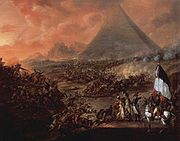
Siege of Acre (1799)
The Siege of Acre of 1799 was an unsuccessful French siege of the Ottoman-defended, walled city of Acre and was the turning point of Napoleon's invasion of Egypt and Syria.-Background:...
in 1799, and at the Battle of Abukir
Battle of Abukir (1801)
The Battle of Abukir of 8 March 1801 was the second battle of the Egyptian campaign in the French Revolutionary Wars, to be fought at Abu Qir on the Mediterranean coast, near the Nile delta. A British army of 5,000 led by General Ralph Abercromby landed along the beach to dislodge an entrenched...
in 1801, so that by 1802, the French were completely vanquished in the Middle-East. Soon however, from 1803, Napoleon went to great lengths to try to convince the Ottoman Empire to fight against Russia
Russia
Russia or , officially known as both Russia and the Russian Federation , is a country in northern Eurasia. It is a federal semi-presidential republic, comprising 83 federal subjects...
in the Balkans
Balkans
The Balkans is a geopolitical and cultural region of southeastern Europe...
and join his anti-Russian coalition. Napoleon sent General Horace Sebastiani as envoy extraordinary, promising to help the Ottoman Empire recover lost territories. Napoleon also formed a Franco-Persian alliance
Franco-Persian alliance
A Franco-Persian alliance was formed for a short period between the French Empire of Napoleon I and the Persian Empire of Fath Ali Shah against Russia and Great Britain between 1807 to 1809. The alliance was part of a grand Napoleonic scheme to cross the Middle East in order to attack British India...
in 1807, with the continuous aim of linking with India.
Napoleon's interest in the Middle-East and India waned when he finally vanquished Russia at the Battle of Friedland
Battle of Friedland
The Battle of Friedland saw Napoleon I's French army decisively defeat Count von Bennigsen's Russian army about twenty-seven miles southeast of Königsberg...
in July 1807, leading to the Treaty of Tilsit, in December 1807. France as an ally of Russia became a strong repellent to both the Ottoman Empire
Ottoman Empire
The Ottoman EmpireIt was usually referred to as the "Ottoman Empire", the "Turkish Empire", the "Ottoman Caliphate" or more commonly "Turkey" by its contemporaries...
and Persia. Great Britain signed a mutual defense treaty with Shah Shuja al-Mulk of Afghanistan
Afghanistan
Afghanistan , officially the Islamic Republic of Afghanistan, is a landlocked country located in the centre of Asia, forming South Asia, Central Asia and the Middle East. With a population of about 29 million, it has an area of , making it the 42nd most populous and 41st largest nation in the world...
on 17 June 1809 in order to better resist the Franco-Persian threat, but by that time Persia had already denounced its alliance with France and was moving towards Great Britain. These last events rendered the Franco-Indian alliance impossible to pursue further.

